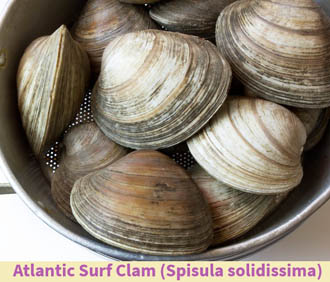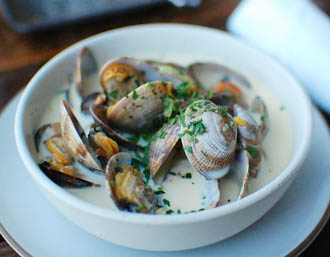Atlantic surf clam Nutrition facts
Atlantic surf clam is a bivalve mollusk found along the Atlantic coast of North America, ranging from Nova Scotia, Canada, to the Gulf of Mexico. They are a good source of protein, vitamins, and minerals, contributing to their popularity among health-conscious consumers looking for nutritious seafood options and are appreciated for their taste, versatility, and contribution to various dishes as well.
Scientic name: Spisula solidissima. They are also known by Surfclam, Hen clam, Bar clam, Sea clam.
 |
| Courtesy: Virginia Sea Grant |
Description
Atlantic surf clams are the largest bivalves found in the western North Atlantic. They grow up to 8 inches, although most clams harvested are about 5-6 inches in length.
Their shells are thick, triangular, and yellowish-white with rounded edges and concentric ridges.
Biology and Habitat
Atlantic surf clams inhabit sandy ocean bottoms in intertidal and shallow subtidal zones, typically buried in the sand from the shoreline to depths of around 60 feet (18 meters). These clams prefer sandy or muddy substrates where they can bury themselves and filter feed on planktonic organisms.
Atlantic surf clams reproduce through spawning which typically occurs in late spring or early summer. They can live for 20 years or more.
Health benefits of Atlantic surf clam (Giant clams)
Giant clams are a low-calorie, low-fat seafood choice. 100 grams (3.5 oz) of its lean, white meat contains just 86 calories and 1 gram of fat.
Surf clams are an excellent source of high-quality protein, containing 14.7 grams per 100 grams (26.25% of the RDI). Complete protein with all the essential amino acids is crucial for cell repair, muscle development, and overall growth in the body.
Clam meat is also a moderate source of omega-3 fatty acids, particularly EPA (eicosapentaenoic acid) and DHA (docosahexaenoic acid). Omega-3s are known for their role in supporting heart health, reducing inflammation, and promoting brain function.
Research studies indicate that seafood consumption can reduce the risk of heart attacks, strokes, obesity, and hypertension. Seafood is low in saturated fat and rich in "heart-healthy" polyunsaturated fat, including omega-3 fatty acids. The American Heart Association recommends seafood due to its diverse range of nutrients, essential fatty acids, vitamins, and minerals that play vital roles in metabolic functions.
Atlantic surf clam contains good amounts of B-complex vitamins like folate, niacin, vitamin B6, thiamin, and riboflavin.
100 g fresh clam meat provides 300 IU or 10% of daily-required levels of vitamin-A. It is one of the essential vitamins needed for healthy vision and immunity. Vitamin A is an antioxidant that is required for the integrity of healthy mucosa and skin. Consumption of foods rich in vitamin A is known to protect from lung and oral cavity cancers.
Giant clams are rich source of minerals, including iodine, iron (20% of the Daily Intake per 3.5 oz servings) phosphorus (198 mg or 28% of the DI), selenium (56% of the DI), calcium, zinc, potassium, and magnesium.
Surf clam meat contains very small but permissible levels (0.009 Parts Per Million (PPM)) of methyl-mercury, making it a safer choice, especially for pregnant women and young children. The Food and Drug Administration (FDA) recommends that pregnant women consume at least 8 to 12 ounces (about 340 grams) of seafood with low mercury content per week.
| Principle | Nutrient Value | Percent of RDA |
|---|---|---|
| Energy | 86 Kcal | 4.25% |
| Carbohydrates | 3.57 g | 2.75% |
| Protein | 14.7 g | 26.25% |
| Total Fat | 0.96 g | 5% |
| Cholesterol | 30 mg | 10% |
| Dietary Fiber | 0 g | 0% |
| Vitamins | ||
| Folates | 5 μg | 1.25% |
| Niacin | 0.35 mg | 2.2% |
| Pyridoxine (B-6) | 0.01 mg | <1% |
| Riboflavin | 0.04 mg | 3% |
| Thiamin | 0.015 mg | 1% |
| Vitamin-A | 300 IU | 10% |
| Vitamin-C | 0 mg | 0% | Electrolytes |
| Sodium | 601 mg | 40% |
| Potassium | 46 mg | 1% |
| Minerals | ||
| Calcium | 39 mg | 4% |
| Copper | 0.053 mg | <1% |
| Iron | 1.62 mg | 20% |
| Magnesium | 19 mg | 4% |
| Manganese | 0.085 mg | 4% |
| Phosphorus | 198 mg | 28% |
| Selenium | 30.6 μg | 56% |
| Zinc | 0.51 mg | 4.5% |
| Omega-3 fats (PUFA) | ||
| EPA (20:5 n-3) | 0.043 g | -- |
| DPA (22:5 n-3) | 0.007 g | -- |
| DHA (22:6 n-3) | 0.064 g | -- |
Buying
Fresh, live Atlantic surf clams are available year-round. Look for clams that have tightly closed shells or ones that close immediately when tapped. Avoid those that are open or have broken or damaged shells. Choose clams that feel heavy for their size.
Fresh clams should have a clean and slightly salty ocean smell. Avoid clams that have a strong, foul odor, as this indicates spoilage.
They are also sold processed and frozen, and canned.
Its raw meat is whitish-orange; however, cooked meat appears whitish-yellow. When cooked, the meat is mild and sweet and chewy.
Storing
it is essential to store them properly. Keep them refrigerated at a temperature between 32°F and 45°F (0°C to 7°C) and use them as soon as possible for the best flavor and quality.
Preparation and serving methods
It is important you clean surf clams before use in cooking. Place the clams in a bowl of cold water and let them soak for 20-30 minutes. This helps to purge the clams of sand and grit.
Scrub the shells for removing external impurities. Then, with a knife, carefully open the clam by inserting the blade into the shell's opening. Slide the knife along the inside of the top shell to separate the clam from the shell. Take care not to spill any liquid from inside the shell.
Rinse the opened clam again under cold water and use a soft brush to gently remove any inner impurities.
Here are some serving ideas:
Atlantic surf clams, also known as bar clams or hen clams, are versatile seafood options that can be used in various recipes. These clams are utilized in numerous recipes, including clam chowder, seafood stews, pasta dishes, sushi, ceviche, and more.
 |
| Surf clam chowder. Photo: Jen |
Prepare surf clam chowder using ingredients such as bacon, chopped onion, diced celery stalks, potatoes, milk and cream and seasoned with salt and pepper to taste. Serve hot, garnished with the crispy bacon.
Surf clam linguine is a popular Italian pasta dish served traditionally with pesto sauce.
Serve the stuffed surf clams hot as an appetizer or side dish.
Serve the surf clam fritters warm with your choice of dipping sauce, such as tartar sauce, aioli, or a squeeze of lemon.
Safety profile
Eating raw or undercooked clams leads to vibrio bacteria (Vibrio vulnificus) infection that can cause gastrointestinal illness. Thorough cooking destroys these bacteria and makes them safe to consume. Discard any clams that do not open during cooking.
Shellfish including Atlantic surf clam is a common food allergy which may affect around 1% of the population. Most of these allergic manifestations are mild to moderate in severity, ranging from hives (urticaria), tingling of the throat and mouth, swelling (angioedema), and gastrointestinal (vomiting, diarrhea).
Clam has methyl-mercury levels of 0.009 Parts Per Million (PPM). According to the U.S. FDA guidelines for expectant and breastfeeding mothers, it is categorized into the "best choice", allowing it to consume 2-3 servings per week. (Medical disclaimer).
Also read ≻≻-
≺≺- Mercury in Fish: Health Benefits, Risks, and Safe Choices
≺≺ Shrimp nutrition facts and health advantages.
≺≺ Lobster nutrition facts and health benefits.
≺≺ Trout nutrition facts and health benefits.
≺≺ Anchovies nutrition facts and health benefits.
≺≺ Back to Seafood from Atlantic Surf clam nutrition facts and Health benefits.
Further reading (Links opens in new window):
NOAA-Fisheries -Spisula solidissima.
Omega-3 Fatty Acids: An Essential Contribution.
U.S. Food & Drug Administration- Mercury Levels in Commercial Fish and Shellfish.